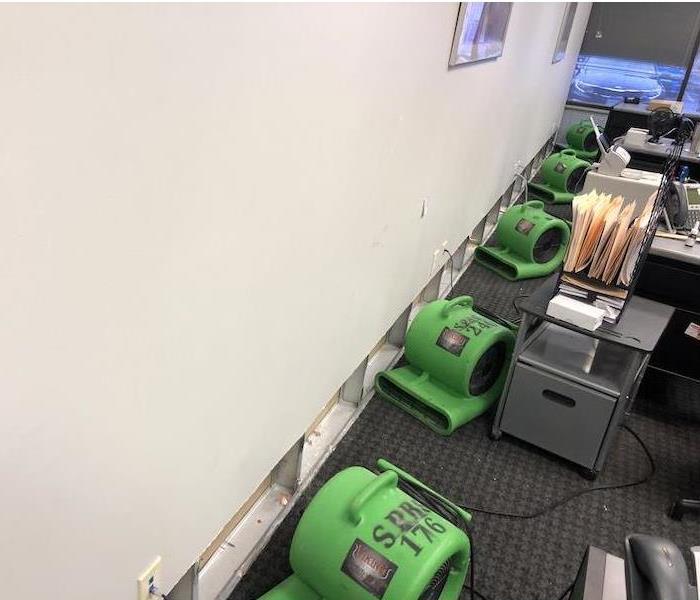Who is responsible for a water leak in a property, the landlord or the tenant?
5/20/2020 (Permalink)
SERVPRO can advise you on some steps from being a renter to being an owner.
The responsible for most restoration work in a property lies with the landlord. If you are renting a freehold property, you are likely only responsible for a small portion of the property and not the building or tenant's possessions. If a tenant does report flooding or water leaks, you should respond quickly to maintain good relations and protect your property from potentially expensive damages. At SERVPRO, we work closely with landlords and other businesses to help recover losses urgently.
If I am renting a freehold property to tenants, what am I responsible for in a water emergency?
Contracts differ, and you should check with both your freeholder and your insurance provider about coverage when organizing commercial water cleanup in San Antonio. Generally speaking, you are likely to be responsible for fittings and fixtures in the property. These include any permanent attachments in the property such as linoleum, carpeting and potentially some appliances. Water can cause significant damage to fittings and fixtures as well as being a high risk for secondary water damages like mold growth.
What can I do to restore the property's fittings and fixtures after a water leak?
- Instructing your tenants to shut-off the water supply is essential to controlling losses in a water incident
- You can expect to need both water extraction and drying services to bring the property back to its original state successfully
- Removing carpets may be beneficial to prevent them from soaking the subfloor allow airflow beneath- floating carpets may be vital to preventing microbial growth
- Expert pre-conditioning and carpet cleaning may be necessary depending on the type of water as well as the length of exposure to moisture for the carpet- longer than seventy-two hours can lead to permanent harm
- Professional restorers can detach and reinstall carpets without risking further harm
Is bonnet cleaning an effective way to restore wet carpets?
Bonnet cleaning is a useful method that is the least aggressive on carpets. However, you may risk causing further harm if the carpets are delaminating, the seams are loose or on thick fiber carpets. SERVPRO technicians can carefully detach the carpet to inspect areas of risk before performing bonnet cleaning. We first vacuum the carpet to prevent any residual grit from causing damage during rotary cleaning. Remember to moisten the bonnet pad before working. The heat and friction that this method produces can harm dry carpet fibers if misapplied.
Is there a difference between clean water spills and water leaks from unclean supplies?
Clean water spills can generally return to a good condition with light intervention. However, water can deteriorate other times and with the interaction of other substances. The longer water sits, the more likely it is to deteriorate. This deterioration can make carpet cleaning more challenging for landlords. We offer cleaning services for any scale of water contamination, including black water caused by sewer backups or flooding.
Landlords can benefit from our hot water extraction technique which is very effective on moderate carpet soiling. The RX-20 is a rotary extraction tool that releases a liquid or powder emulsifier directly onto the carpet surface. Using the inbuilt vacuum of the RX-20 restorers can continually run over the affected area until the soils, water and solution are sufficiently extracted. Any cleaning wastes from extraction are securely stored in tanks for disposal in an open sewer point or at a wastewater facility.
As an owner of multiple flats in the same building, do I need to arrange services individually for each tenant?
SERVPRO commercial restoration teams are large enough to cover a set of flats in one arranged service. Our business emergency contact line is available twenty-four hours a day for commercial clients. During your service, we can communicate with you throughout to ensure that we are performing as you expect. We can also benefit from your intimate knowledge of architecture, build and any warranties you may have to ensure a smooth procedure from start to finish.
What are the dangerous factors of a water emergency?
- Water migration can result in damp spots inside wall-cavities. These can be tough to spot and challenging to restore. Without proper care, they can cause significant harm
- Water deterioration can result in rising costs. Mold colonies can form in as little as forty-eight hours in ideal conditions
- Safety concerns from slip and trip hazards are a critical factor in any restoration involving water
- Subfloor inspections are essential to ensure there are no hidden damages that could occur further down the line.
The fastest way to recover from a commercial water emergency is to enlist professional assistance. Our teams are here to help guide you through the recovery procedure and ensure that there are no unforeseen damages like mold growth. If your business suffers from a water emergency, contact SERVPRO of Braun Station at (210) 267-2159.
To learn more about San Antonio, click here.





 24/7 Emergency Service
24/7 Emergency Service
